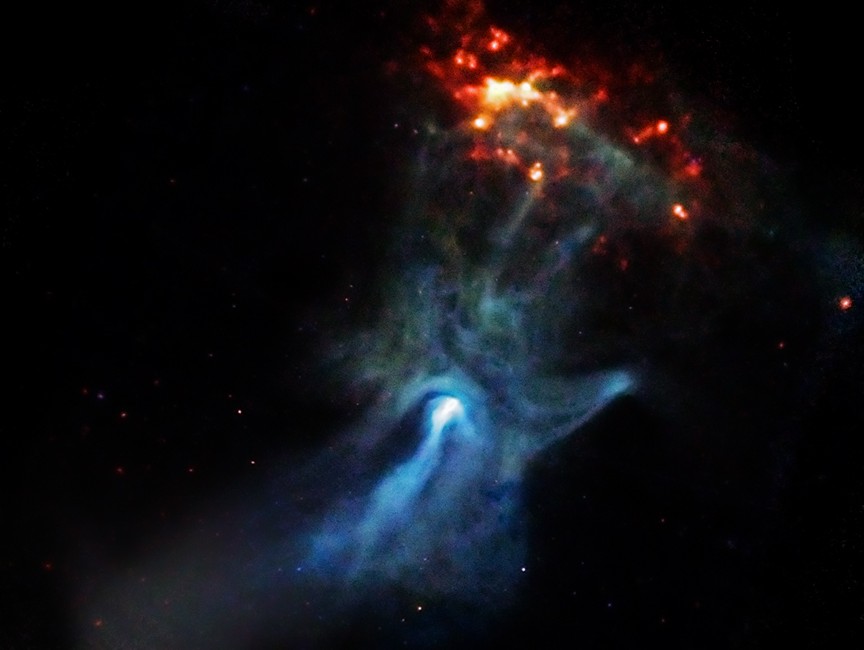A Pulsar’s Hand.
From Nemiroff and Bonnell: Astronomy Picture of the Day – 2010 May 1.

Credit: P. Slane (Harvard-Smithsonian CfA) et al., CXC, NASA
Explanation: “As far as pulsars go, PSR B1509-58 appears young. Light from the supernova explosion that gave birth to it would have first reached Earth some 1,700 years ago. The magnetized, 20 kilometer-diameter neutron star spins 7 times per second, a cosmic dynamo that powers a wind of charged particles. The energetic wind creates the surrounding nebula’s X-ray glow in this tantalizing image from the Chandra X-ray Observatory. Low energy X-rays are in red, medium energies in green, and high energies in blue. The pulsar itself is in the bright central region. Remarkably, the nebula’s tantalizing, complicated structure resembles a hand. PSR B1509-58 is about 17,000 light- years away in the southern constellation Circinus. At that distance the Chandra image spans 100 light-years. ” [Links are from the APOD original.]
(A service of NASA. Discover the cosmos! Each day a different image or photograph of our fascinating universe is featured, along with a brief explanation written by a professional astronomer.)
Astronomy Picture of the Day. Authors & editors: Robert Nemiroff (MTU) & Jerry Bonnell (UMCP).
Additional information on neutron stars:
From an article excerpt suggested on the Astronomy picture of the day 9/30/18 post. [APOD, 2018 September 30. https://apod.nasa.gov/apod/ap180930.html “The Lonely Neutron Star in Supernova Remnant E0102-2.3” Credit: X-ray (NASA/CXC/ESO/F. Vogt et al.); Optical (ESO/VLT/MUSE & NASA/STScI)] https://en.wikipedia.org/wiki/Neutron_star
Neutron stars. “A neutron star is the collapsed core of a giant star which before collapse had a total of between 10 and 29 solar masses. Neutron stars are the smallest and densest stars, not counting hypothetical quark stars and strange stars.[1] Neutron stars have a radius on the order of 10 kilometres (6.2 mi) and a mass between 1.4 and 2.16solar masses.[2] They result from the supernova explosion of a massive star, combined with gravitational collapse, that compresses the core past white dwarf star density to that of atomic nuclei.
Once formed, they no longer actively generate heat, and cool over time; however, they may still evolve further through collision or accretion. Most of the basic models for these objects imply that neutron stars are composed almost entirely of neutrons (subatomic particles with no net electrical charge and with slightly larger mass than protons); the electrons and protons present in normal matter combine to produce neutrons at the conditions in a neutron star. Neutron stars are supported against further collapse by neutron degeneracy pressure, a phenomenon described by the Pauli exclusion principle, just as white dwarfs are supported against collapse by electron degeneracy pressure. If the remnant star has a mass greater than about 3 solar masses, it continues collapsing to form a black hole.
Neutron stars that can be observed are very hot and typically have a surface temperature of around 600,000 K.[3][4][5][6][a] They are so dense that a normal-sized matchbox containing neutron-star material would have a weight of approximately 3 billion tonnes, the same weight as a 0.5 cubic kilometre chunk of the Earth (a cube with edges of about 800 metres).[7][8] Their magnetic fields are between 108 and 1015 (100 million to 1 quadrillion) times as strong as that of the Earth. The gravitational field at the neutron star’s surface is about 2×1011 (200 billion) times that of the Earth.
As the star’s core collapses, its rotation rate increases as a result of conservation of angular momentum, hence newly formed neutron stars rotate at up to several hundred times per second. Some neutron stars emit beams of electromagnetic radiation that make them detectable as pulsars. Indeed, the discovery of pulsars by Jocelyn Bell Burnell in 1967 was the first observational suggestion that neutron stars exist. The radiation from pulsars is thought to be primarily emitted from regions near their magnetic poles. If the magnetic poles do not coincide with the rotational axis of the neutron star, the emission beam will sweep the sky, and when seen from a distance, if the observer is somewhere in the path of the beam, it will appear as pulses of radiation coming from a fixed point in space (the so-called “lighthouse effect”). The fastest-spinning neutron star known is PSR J1748-2446ad, rotating at a rate of 716 times a second[9][10] or 43,000 revolutions per minute, giving a linear speed at the surface on the order of 0.24 c (i.e. nearly a quarter the speed of light). …” [Emphasis added.] https://en.wikipedia.org/wiki/Neutron_star


![Mozart. The Piano [3].](https://i0.wp.com/discoverhpl.org/wp-content/uploads/2022/09/fall-forest-1100x740-1.jpg?fit=1100%2C740&ssl=1&resize=372%2C246)